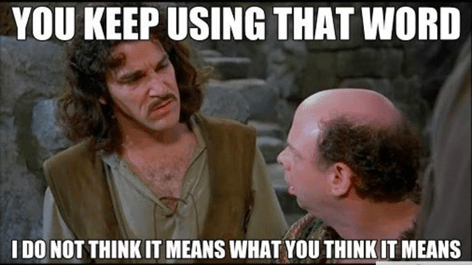What are they Thinking?: Understanding the Mind and Values of the Woke – Part 3 Towards Postmodernism: The Rise of Linguistic Theories
The End of Optimism

The first post in this series: “What are they Thinking?: Understanding the Mind and Values of the Woke – Part 1 Living in ‘Escher’s World’” addressed how the contemporary Social Justice movement arose out of the convergence of Neo-Marxism and Postmodernism. The second post, “What are they Thinking?: Understanding the Mind and Values of the Woke – Part 2 The Failure and Reinvention of Marxism” looked at the transition that took place from classic Marxism to Neo-Marxism.
The Failure of Modernism
At this point in this study, terms become harder and harder to define. The first such term is “modernism” or “modernity.” The main thing that might strike the non-philosopher is that modern just means the very recent past or the present. This makes the term “postmodern” sound absurd because it means that we are living after the present. Likewise, the term “modernism” is most clearly used in the arts, as one can speak of modern art or modern architecture. When speaking more broadly of modernism, little real consensus exists. In fact, the exhaustive Stanford Encyclopedia of Philosophy has an entry for postmodernism, but not for modernism.[1] This, however, has not stopped the writing of countless books that critique, respond to, or explain modernism.[2]
For some, modernism encapsulates the whole of thinking from Rene Descartes (1596-1650) until the early 20th century; others take a more narrow view restricting it to the 19th and early 20th centuries. For the sake of this study, the latter view will be used. This era was a time of great optimism and scientific development. The Industrial Revolution and inventions like the automobile and the electric light showed the promise, which has since been fulfilled, of remaking how our world works. Overall, there was a belief that man was the center of all things, and, given enough time, humanity could answer all its problems and bring in an era of ever-increasing prosperity, peace, and happiness. However, early in the 20th century, this optimism crumbled. Suddenly, the world was rocked with a series of calamities. The sinking of the “unsinkable” Titanic in 1912 became emblematic of human arrogance and the failure of technology. The First World War then showed that modern technology was being used not just for good, but also to create more efficient ways to kill large numbers of people. The Second World War took this even further with the carpet bombing of cities, unmanned rocket bombs and ultimately the atomic bomb. At the same time, man’s cruelty to his fellow man reached new heights in the Holocaust, the Holodomor, Khmer Rouge, and other atrocities.
During this time, philosophy also turned on itself as it narrowed what it said could be known to fewer and fewer things. The movement of Logical Positivism went so far as to argue that any statement that did not point to a physical reality was nonsense. There was a general despair that we were not making any real progress and that we could not really know anything.
Towards Postmodernism
As the hopes of modernism failed, philosophy shifted to what is now known as postmodernism. Postmodernism is a loose term for what happened after the optimism of modernism had passed. The very term “postmodernism” doesn’t describe anything about the movement, only that it was after modernism. This very term is, therefore, an illustration of the intellectual despair of the mid to late 20th century.
At this time, philosophy turned to examine if our language could even be trusted. As we will see, language ultimately came to be viewed as completely arbitrary. No longer were words thought to express reality, only our views as formed by our social groups.
Structuralism
Curiously, much of this movement first took place within literary theory. The first move in this direction was the development of structuralism. Structuralism argues that any piece of writing (or any “signifying system”) derives from pre-existing structures in society that enable us to understand the world. We are therefore formed by our language and the society to look at things in certain ways. Structuralism argues that there are deep structures at the heart of human thinking and therefore human language. These structures tend to deal with binary opposites which are contrary to each other and therefore need some sort of mythical mediation in the form of stories.[3]
Structuralism therefore defined every story as the clash between irreconcilable opposites. These opposites include Good vs. Evil, Black vs. White, Male vs. Female, War vs. Peace, Civilized vs. Savage, Democracy vs. Dictatorship. Countless examples of these can be seen in literature and movies. For instance, all romance novels and movies are about trying to reconcile the opposites of male and female; Star Wars, Harry Potter, and the stereotypical Western movie with the good guys in white hats and the bad guys in black hats are obvious examples of good vs. evil.
Post-Structuralism
It did not take long for thinkers to argue that there are, in fact, no deep structures in the world. As a result, structuralism soon gave way to post-structuralism. The post-structuralist argues that all language, and therefore all knowledge, is inherently arbitrary as each society has made up its own language and ways of understanding things.[4] After all, if a furry creature with a wagging tail, a snout with pronounced canine teeth, and trots up to us barking, there is nothing in that creature that says that it is a “dog.” In fact, this animal just as rightly can be called a “chien,” “perro,” or “Hund” depending on the society in which one lives. So, why do we call it a “dog?” It is merely a cultural convention, and we could just as easily, as a culture, call this creature a “bottle rocket” or any other term that becomes acceptable.[5]
For Post-Structuralists, there either is no objective truth or, more commonly, there may be an objective truth, but we are too bound by our socially formed perspective to see any objective truth that may exist. Since everyone thinks in words, the words that we use guide what we think and even which thoughts we can think and which ones we cannot think. For instance, a desert culture that has no knowledge or words for snow provides no mental category for its members to think about snow or even comprehend this type of thing. Far more importantly, however, it is argued that concepts of truth, justice, fairness, etc. are always mediated by our culture.
A good example of how a society can change how it views and uses a word can be seen today as we find debates over which words are acceptable. For instance, in 2016 Harvard University eliminated the title “House Master” because the title “master” was considered to be tied to slavery.[6] In this case, the protesters used the social construct of master/slave with which to interpret this title and therefore found it offensive. However, the historic educational understanding of the word comes from the Latin magister meaning a tradesman or subject expert who is qualified to teach others. As a result, there was a change in cultural understanding that shifted this word from acceptable and appropriate to unacceptable and needing to be removed.
Agreeing with structuralism, post-structuralism holds that there are binary opposites but that these are just societal constructs. Ultimately, the argument is that every society creates binary opposites through its language; this means that the social environment of the author helps direct what an author says, and then the social environment of the reader directs how the reader reads the text. This means that the binary opposites that we use in stories and thought are really just social constructs and do not reflect reality. A good example of this is in how there is nothing objective to say that cowboys are good and American Indians are bad as was depicted in so many books and old Western movies. Hence, this was challenged in the post-structural movie Dances with Wolves.[7]
The post-structuralist argues that because of this, the actual words of a text have no inherent meaning, they are just drips of ink on a page. Rather, the reader is the one who must interpret this ink and, in so doing, is the one who gives meaning to the words. Hence, since the reader has been formed differently by society than the author, the reader cannot truly know what the author intended. Therefore, what is important is not what an author writes, but how the reader, formed by their society, responds to a given work. This means that the reader is the one who is creating meaning from a text, rather than receiving meaning from the text.[8]
The next post in this series will look at the rise of Deconstruction.
[1] Zalta, Edward N. and Uri Nodelman, eds., “Stanford Encyclopedia of Philosophy,” n.d., https://plato.stanford.edu/.
[2] Examples include Michael Allen Gillespie, The Theological Origins of Modernity (Chicago : University of Chicago Press, 2008); Gerald J. Galgan, The Logic of Modernity (New York: New York University Press, 1982); and the magisterial work Charles Taylor, A Secular Age (Cambridge, Mass.: Belknap Press of Harvard University Press, 2007).
[3] Hicks, Explaining Postmodernism, 43-44.
[4] James Williams, Understanding Poststructuralism (London, UNITED KINGDOM: Taylor & Francis Group, 2014), http://ebookcentral.proquest.com/lib/dtl/detail.action?docID=1900170.
[5] A fun children’s book that explores this is: Andrew Clements, Frindle, First edition. (New York, N.Y.: Simon & Schuster Books for Young Readers, 1996).
[6] “Harvard Abolishes ‘master’ in Titles in Slavery Row,” BBC News, 25 February 2016, § Education & Family, https://www.bbc.com/news/education-35659685.
[7] Dances with Wolves, directed by Kevin Costner (Orion Pictures, 1990).
[8] Gene Edward Veith Jr and Marvin Olasky, Postmodern Times: A Christian Guide to Contemporary Thought and Culture, First Paperback Printing edition. (Wheaton, Ill: Crossway, 1994).




